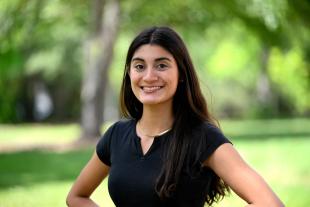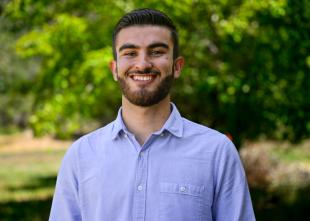'I'm Incredibly Proud.' How Teaching Credential Candidates Adapted to Virtual Learning
Lisette Brown, a teaching credential candidate in Cal Poly’s School of Education, always carpooled to her student teaching assignment in Santa Maria with some of her fellow candidates.
“The drives were good times to connect and share fun stories about our days with our students,” Brown said.
March 13 was the last day Brown was able to be in the classroom with her students. The following Sunday, the school district announced that all classes were moved to virtual instruction. Over that weekend, every school district on the Central Coast moved their operations to virtual formats.
“We’re still able to text and chat on the phone sometimes, but I missed seeing my friends and my students,” said Brown, who completed her credential program in June after a quarter of virtual student teaching and online courses at Cal Poly. Throughout their yearlong program, candidates in the credential program spend progressively more time in a local classroom with cooperating teachers, taking on greater responsibilities as well. For many candidates in the credential program, the spring quarter was their opportunity to teach full-time and interact in person with students for the entire school day.
“It’s why you get into teaching,” said Marisol Zepeda, a candidate in the single subject program, focused on life sciences. “That missed face time was the most challenging part of the quarter.”

In the transition to virtual teaching and learning, credential candidates, along with their cooperating teachers and their Cal Poly instructors, utilized several new technologies and teaching methods to make a connection with their students.
Many of the candidates worked with students who already were used to some online component of their classes. Google Classroom was widely used by candidates and their students throughout the year. The software allows users to upload rubrics, run originality tests, and can be synchronized with student schedules and emails.
“I’d say it’s easier than PolyLearn,” said Devyn Gonsalves, a single subject candidate and Cal Poly graduate.
Briana Ronan, an assistant professor in the School of Education and coordinator of the Bilingual Authorization Program, developed a YouTube playlist of stories in both Spanish and English so that candidates could still have story time with their young students.
“School of Education candidates and alumni put the content together and we were able to find a way to share them with our students and their families so that they could still have that shared experience of reading,” Ronan said. “I even heard from teachers around the country that they were using our videos too!”
Nolan Cope, who completed his single subject credential in social science in June, produced videos of himself explaining topics in history, including the Cold War and China in the 20th century.
Katelin Bergman, a multiple subject credential candidate, used programs like Flipgrid and Kahoot! to create virtual games and assignments for her class of fourth graders. Bergman was impressed with how her students, mostly 9- and 10-year-olds, adapted.
“I am constantly impressed with them,” she said. “They already have great email etiquette!”
Carlie Jones, who completed her credential program in June and will be teaching at a local school this fall, added, “Some of my students definitely adapted better than adults.”
Many candidates sought to highlight the role of their students’ families when they were learning from home. Candidates encouraged their students to engage with their families, their household and their communities when possible during their time learning at home. The home-based learning approach finds what is available to students at home and uses that to drive the students’ educational experience.
“I gave my students the opportunity to give tours of their home or show PowerPoints about themselves so I could get to know them virtually,” said Taylor Spainhour, who completed her credential in June. “It was a fun way for us to still make a connection, regardless of distance.”
Gonsalves asked her class of high school seniors to find a book, piece of music, movie or other piece of content that they had at their home, find a scholarly article on the content, and build a portfolio around the topic.
“It felt like a fun way for them to do something different than a typical book report,” said Gonsalves.
Tiffany Farfan, a multiple subject candidate who was teaching virtually from her family’s home, found ways to involve her parents as well. Farfan interviewed her mother on video about their family’s history and background and prompted her students to do the same with their own family members. She also made a video with her father in which they counted model cars as a math lesson for her students.
In addition to helping their students adjust to virtual learning, credential candidates had to adapt to their Cal Poly courses moving online as well. Leah Wood, an associate professor and co-coordinator of the School of Education’s specialization in special education programs, had to adjust her courses that involved a lot of hands-on and collaborative work between candidates, as well as time for them to hear from professionals in the special education field.
“The spring quarter is the culminating quarter for candidates in the special education program and a time for them to really engage with stakeholders in the field,” Wood said. “As professors, we had to build our students up and help them feel like they could still succeed.”
Jones said she felt incredibly supported by her professors during the difficult spring quarter.
“Professors would check in often and were just as, if not more, responsive to me,” she said. “Dr. Wood would send out different technology support options to us every week, and we had the opportunity to hear from experts over Zoom and talk about how we deliver special education services virtually.”
With the end of the spring quarter, many of the candidates will be either teaching their own classes full time in the fall or continuing with the credential program. In reflecting on the spring quarter, the candidates found the positives in their experience and are thinking of how it can inform their future teaching.
“Regardless of how the beginning of the school year looks, I know I need to immerse myself in how I’m going to improve my teaching and how I’m going to make it more equitable,” Zepeda said.
“It was heartening to see how our candidates took this challenge in stride,” said Julee Bauer, co-coordinator of the multiple subject credential program. “They weren’t afraid to try new teaching techniques. They saw this new online model as an opportunity to work with their professors and their co-teachers to develop new teaching skills together.
“I’m incredibly proud of what our candidates did over the past quarter.”




